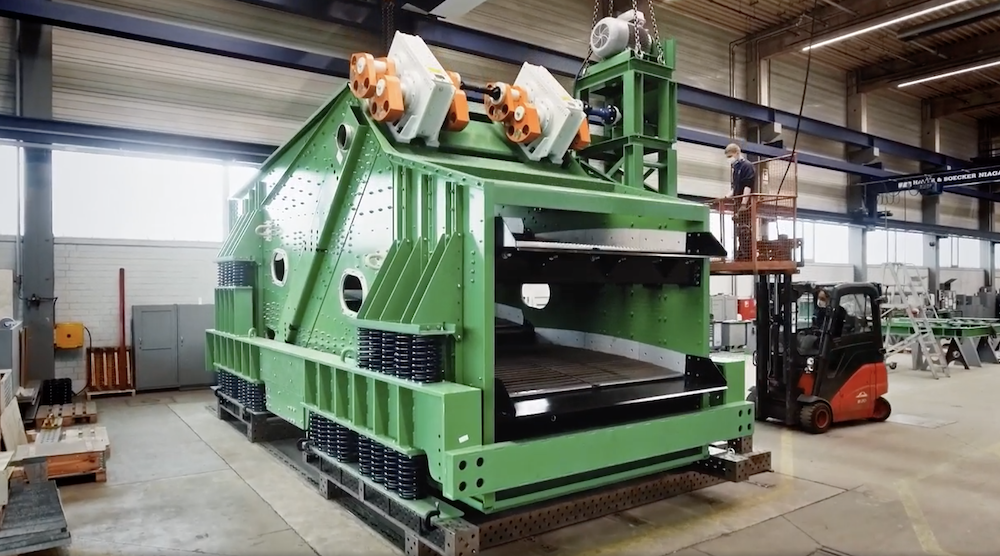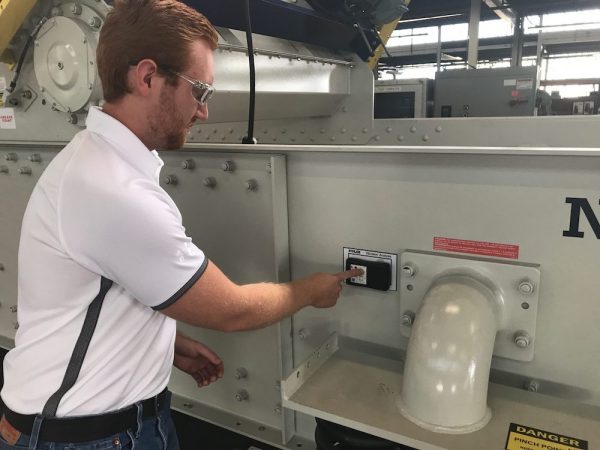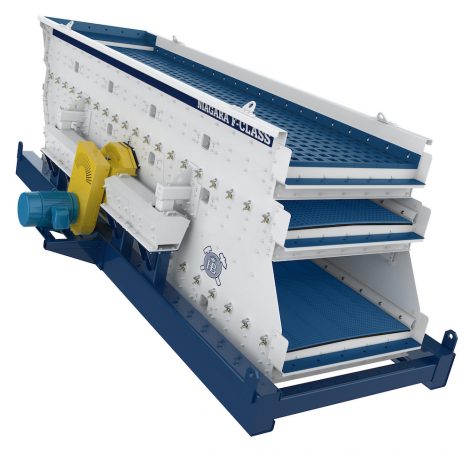
News
Products & Equipment
Pits & Quarries
Technology
Haver & Boecker Niagara debuts new equipment at MINExpo
September 14, 2021 By Rock to Road Staff
 Haver & Boecker Niagara's exciters are on display for the first time at MINExpo. Photo: Haver & Boecker Niagara
Haver & Boecker Niagara's exciters are on display for the first time at MINExpo. Photo: Haver & Boecker Niagara Haver & Boecker Niagara is at MINExpo in Las Vegas this week showcasing several new or upgraded pieces of equipment.
In a virtual booth tour with Rock to Road, Kristen Randall, marketing manager for Haver & Boecker Niagara, said customer input was critical in developing the improvements.
“A lot of our customer feedback is, ‘maintenance is so important to us, safety’s so important to us, uptime is so important to us,'” she said. “[Customers ask] ‘how do we maximize all those things? How do we make our plant safer, how do we make sure we keep our machines running, how do we extend longevity of our equipment?'”
Here’s a rundown of what’s new and improved:
Pulse impact testing
Haver & Boecker Niagara has added an impact test to its Pulse portfolio, which also includes condition monitoring and vibration analysis.
The impact test – also known as the hammer test or bump test – is now part of the company’s quality assurance program during factory testing and on site.
The test ensures each machine is properly tuned to avoid operating in resonance. Operating in resonance can diminish productivity, incur damage to vibrating screens and pose safety risks.
Impact testing involves striking the machine at key points with a dead blow hammer while the machine is off. It typically includes the four corners but can be expanded to additional areas. Collected data is analyzed to identify the machine’s individual natural frequencies. Based on results, engineers can adjust machine parameters to avoid these frequencies during operation.
The full suite of Pulse diagnostic tools helps operations to monitor the health of vibrating screens for optimum screening performance and equipment durability.
All Pulse Diagnostic Reports are stored in an online data management system, giving customers access to a complete record of their vibrating screen’s service and performance histories.

Pulse impact testing. Photo: Haver & Boecker Niagara
Niagara F-Class vibrating screen
The company’s signature vibrating screen, originally designed in 1935, has been redesigned with maintenance in mind. The new design retains the technical benefits the original F-Class is known for, such as improving performance in material stratification and reducing blinding and pegging.
The vibrating screen now features vibration-resistant lockbolts instead of the traditional welding used in previous designs. Lockbolts are more effective at maintaining structural integrity during the load-bearing, high-vibration operation of a vibrating screen, says the company.
Bar rails are now fastened to the cross beams with lockbolts, making them easier to exchange if they wear down. These cross beams can be positioned and lock-bolted every four feet now instead of every two feet, allowing for better clearance.
The new F-Class design provides the option to upgrade the machine with Haver & Boecker Niagara’s new Drop Guard system. The liners provide protection for the machine’s cross beams to extend the life of the screen. The blue liner drops over the cross beam with no adhesive or tools required.
Additionally, Haver & Boecker Niagara redesigned the flat deck models of the new F-Class to create the largest amount of open area possible for modular screen media.
Featuring replaceable polyurethane anchors, the new high open area modular deck is suitable for virtually any pin and sleeve modular screen media. The anchors prevent premature wear on the deck frame. The open design of the modular deck prevents material build-up on the bar rails.
The F-Class can also be manufactured for side-tensioned or bottom deck end-tensioned screen media. Each new side-tensioned machine comes with Haver & Boecker Niagara’s signature Ty-Rail quick-tensioning system, which reduces the time spent on changing screens.

Niagara F Class vibrating screen. Photo: Haver & Boecker Niagara
Scarabaeus pelletizing disc
The pelletizing disc turns fine materials into pellets to improve their storage and transportation properties. The machine fits into an operation by offering adjustable inclination, speed and side wall height to best fit applicational requirements.
The Scarabaeus pelletizing disc is available in a variety of sizes ranging from 3.2 feet to 24.6 feet (1,000 mm to 7,500 mm).
It features a unique design that optimizes speed and movement to produce high-quality pellet materials. The machine applies a rotating movement combined with water as a liquid-binding agent on the surface of the disc.
The selected material enters the surface of the disc and is pulled along the uppermost side to eventually collect in pellet form in a material bed.
The Scarabaeus 7500 generates a particle distribution of 10-14 mm, at up to 150 tph. The compact pellet size aids in the direct reduction process, which the company says helps to improve sustainability by reducing CO2 emissions.
Parameters of the disc can be automatically adjusted during operation by changing the speed, inclination, mass flow rate and rim height. This feature also helps to minimize recirculation of over- or undersized pellets.
The processing technology is ideal for a variety of applications, from processing different types of ore and fertilizer to salt and fines.

Scarabaeus pelletizing disc. Photo: Haver & Boecker Niagara
Exciters also on display
The company is also highlighting its Niagara Exciters at the show (pictured at top of article), which come standard on all Haver & Boecker Niagara exciter-driven XL-Class and L-Class vibrating screens, and are also available as aftermarket parts for any brand of exciter-driven machine.
The exciters are offered in four models, each of which is adjustable to provide eight weight configurations.
Exciter-driven vibrating screens are ideal for high-tonnage applications and heavy-duty environments, such as dewatering or SAG mill screening, due to the equipment’s strength and advanced sealing system.
Print this page